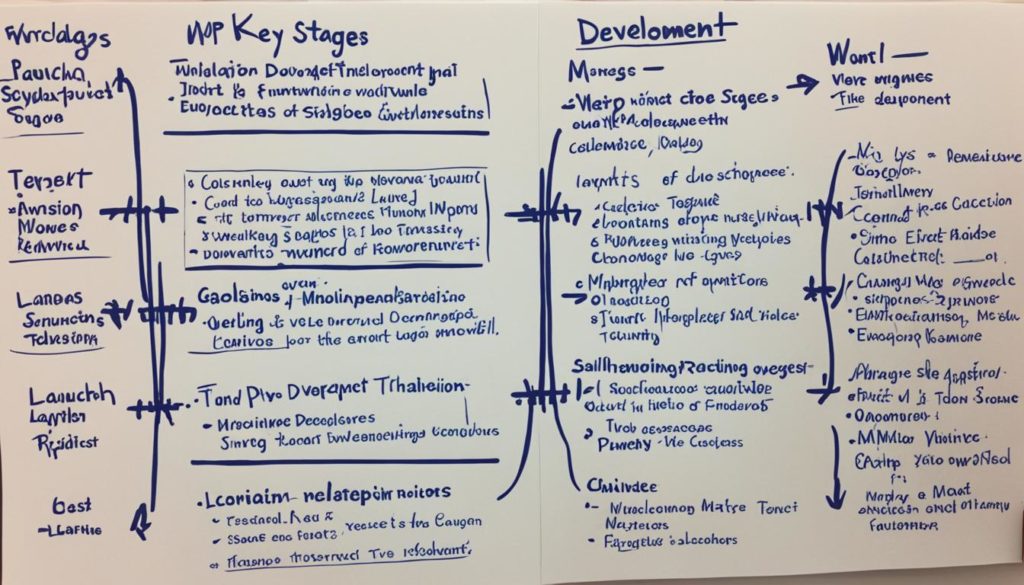
Did you know that over 70% of digital transformation projects fail? This is because they lacked proper planning and support from leaders. It shows how vital it is to have a solid digital transformation strategy. Today, businesses must keep up with fast-changing tech and market trends.
We suggest a full approach that uses the newest tech. It also makes sure people and processes work better. This way, businesses can do better, make more money, and keep customers happy.
Going digital is key. It’s not just about the tech. Getting everyone on board, especially leaders, is crucial for success. Leaders must push for a culture of new ideas and growth. When companies spend wisely on new tech and match their digital plans with their main goals, they can see big gains.
Key Takeaways
- Effective digital transformation strategies are essential for business success.
- Embracing a digital mindset across the organization is crucial.
- Leadership must drive a culture of innovation and growth.
- Clear communication of benefits helps in gaining employee buy-in.
- Proper investment in technology enhances ROI.
Understanding Digital Transformation
Digital transformation is more than just using new tech. It changes how a business works, its culture, and how it treats customers. It’s a big change that touches everything in a company.
Defining Digital Transformation
Digital transformation means using digital tech in every part of a business. This makes big changes in how things work and how customers get value. It’s about keeping up with new digital trends to stay ahead.
The Importance of Embracing Change
This process is not just about tech; it’s about a culture that loves change and new ideas. By following digital trends, companies can get better and give customers a great experience. It helps them move fast when the market changes, keeping them ahead.
It’s key to let go of old ways for new, better ones. This makes businesses run smoother and more effectively.
Impact on Business Growth
Going digital can really help a business grow. Experts say it will add $1.7 trillion to the world economy by 2025. Companies that put digital at their heart get better at changing and growing. They can quickly grab new chances, leading to big success over time.
Promoting a Digital Mindset
Creating a digital mindset in an organization is key for digital success. It starts with making sure employees are on board. This means having strong leadership and a culture that values innovation.
Encouraging Employee Buy-In
To get employees to support digital change, show them how new tools can make their work easier. Explain how these tools can automate tasks, giving them more time for creative work. Offering training and workshops helps them learn about these new technologies.
The Role of Leadership
Leadership is crucial for guiding the organization through digital changes. A Chief Digital Officer can lead the way and keep employees motivated. They make sure the digital plan fits with the company’s big goals, keeping everyone clear on the purpose.
Creating a Culture of Innovation
To build an innovative culture, mix employee skills with new tech. Using Digital Adoption Platforms can make switching to new systems smoother. Encouraging creative thinking and problem-solving in digital areas is key. Activities like brainstorming and hackathons can bring out the best in employees, helping the digital transformation thrive.
| Best Practices | Benefits |
|---|---|
| Encouraging Employee Buy-In | Increased engagement and faster adoption of new tools |
| Strong Leadership Roles | Increased morale and clear vision alignment |
| Innovation Culture | Enhanced creative thinking and improved problem-solving |
Choosing the Right Digital Transformation Framework
Choosing the right digital transformation framework is key for businesses to succeed today. A good framework helps align new tech with the company’s goals. It’s like a roadmap for digital growth.
First, companies must check their tech skills. This helps them see what they’re good at and where they need to improve. It guides where to spend money for the best results.
Big consulting firms like McKinsey and Boston Consulting Group have great models for digital change. These models help make better decisions, improve communication, and focus on customers.
Let’s look at two well-known digital transformation solutions:
| Framework | Key Features | Benefits |
|---|---|---|
| McKinsey’s 4Ds | Diagnosis, Design, Deliver, Develop | Enhanced strategic planning, clear project phases |
| BCG’s Three-Phase Approach | Build the Foundation, Scale Up, Sustain Momentum | Scalability, long-term sustainability |
Using these digital solutions needs careful planning and action. A framework helps keep things steady during big changes. It makes digital transformation smoother and more effective.
In today’s digital world, picking the right framework is crucial for lasting growth, more productivity, and new ideas. This way, businesses can make a strong digital roadmap that fits their goals.
Implementing Effective Digital Transformation Strategies
Success in digital transformation comes from clear strategies that link digital goals with business aims. By linking our digital plans with our company’s mission, we make sure every tech move helps us grow and innovate.
Aligning Digital Goals with Business Objectives
For our digital transformation to work best, we must tie it to our business goals. This ensures every digital step helps our mission, makes things run smoother, and boosts growth. We use clear metrics and KPIs to keep track of progress and stay on track.
Involving All Stakeholders
Getting everyone involved from the start is key for successful digital transformation. By asking for their ideas and keeping them engaged, we build a shared sense of ownership. This makes the change smoother and gets more people on board.
Balancing Technology and Talent
Technology drives change, but talent is just as important. Investing in our people is crucial—offering chances for skill growth and encouraging innovation. By balancing new tech with our team’s skills, we ensure our digital changes are lasting and powerful.
| Key Focus Area | Best Practice | Examples |
|---|---|---|
| Aligning Digital Goals | Integration with Business Objectives | OKR Framework, Balanced Scorecard |
| Involving Stakeholders | Active Engagement and Communication | Workshops, Feedback Loops |
| Balancing Technology and Talent | Continuous Learning and Development | Training Programs, Innovation Labs |
Leveraging Software Solutions for Transformation
Digital transformation is all about using software solutions. These tools help businesses work better and innovate. They make it easier to use technology to grow and improve.
The Role of Software in Digital Transformation
Software is key in our digital transformation. It helps connect different systems and automate tasks. By using digital transformation software, companies can make solutions that fit their needs. This makes them more efficient and helps them use data to innovate and stay ahead.
Integration and Automation
Integrating software is more than just updating tech. It’s about combining systems and automating tasks to make better decisions and improve customer service. With digital technology, we can quickly adapt to changes in the market. Automation helps by making routine tasks easier, so our teams can focus on what really matters for growth. For more tips, check out the Forbes Business Council on using tech for business transformation.
Creating a Digital Transformation Roadmap
In today’s fast-paced business world, having a clear digital transformation roadmap is key. It helps us navigate the big changes brought by new technology. This roadmap is a strategic plan that guides us in using modern digital tools and aligning tech with our business goals.
Key Components of a Roadmap
A successful digital transformation roadmap has several important parts. A clear vision is crucial to push the transformation ahead. Keeping our focus on the customer makes sure our goals improve user experiences and satisfaction. Assessing our current tech gives us a realistic start for the digital transformation strategy. We also need a strong plan for investing in technology to support these changes.
Setting Milestones
Setting milestones is key to tracking our progress in the digital transformation process. These benchmarks let us see how far we’ve come and make sure each step has clear goals. By setting realistic targets, we keep our teams motivated and moving forward.
Monitoring and Adjusting Strategies
Even the best digital transformation roadmap needs ongoing checks and changes. Real-time data, shifting customer needs, and new trends often call for a flexible approach. By regularly checking our progress and being ready to change, we stay agile and keep our energy up during the digital transformation process.
Remember, a roadmap is not just a one-time task but a continuous guide. This ongoing approach lets us tackle new challenges and seize new chances, ensuring our digital transformation strategy succeeds over time.
Conclusion
A successful digital transformation strategy mixes new tech with a shift in culture. It needs strong leadership, engaged employees, and using tech to reach our goals.
By linking our digital plans with our business aims and getting everyone involved, we make a solid digital transformation plan. This way, we’re set for lasting digital growth. We use new tech to its fullest and keep improving.
Knowing how key software solutions and adapting are crucial helps us stay ahead in the digital world. As we keep growing and updating our plans, we secure our spot in the digital economy. This sets us up for lasting success.
FAQ
What are key considerations for successful digital transformation strategies?
For a successful digital transformation, align digital goals with your business aims. Focus on investments that give the best return. Encourage a culture that loves change and innovation.
How do we define digital transformation?
Digital transformation means fully integrating digital tech into all business areas. It changes how operations work and how value is delivered. It’s about having a culture that always seeks new ideas and better ways to do things.
What is the significance of adopting a digital transformation process?
Going through a digital transformation process is key to keeping up with tech changes and market shifts. It makes businesses more efficient, improves how customers are treated, and creates a space for ongoing innovation.
How can we foster a digital mindset within our organization?
Start by getting your team excited about digital tools by showing them the personal benefits. Leaders must push for a culture of new ideas and make sure everyone supports the change efforts.
What role does leadership play in digital transformation?
Leaders are crucial in leading digital transformation. They set the vision and guide the change. They must push for innovation and be strong supporters of change, often with roles like Chief Digital Officer.
How do we choose the right digital transformation framework?
Pick the right framework by looking at your tech skills, setting a clear vision, and matching tech investments with business goals. This method helps in a structured and effective digital strategy.
What are the best practices for implementing digital transformation strategies?
The best ways include getting everyone involved from the start, making sure digital goals match business aims, and balancing tech and talent. This ensures everyone supports the digital efforts and gets the most from them.
How do software solutions contribute to digital transformation?
Software is key in digital transformation by helping with system integration, automating processes, and making businesses more responsive. Custom software can boost efficiency, spark innovation, and give a competitive edge.
What are the key components of a digital transformation roadmap?
A roadmap for digital transformation needs a clear vision, customer-focused solutions, an update on current skills, and a plan for tech investments. Setting goals and keeping an eye on progress is vital for ongoing success.
Why is it important to monitor and adjust digital transformation strategies?
Keeping an eye on and tweaking strategies keeps them working well and in line with new data, customer needs, and trends. This ongoing process helps businesses stay agile and keep moving forward in their digital change.
Future App Studios is an award-winning software development & outsourcing company. Our team of experts is ready to craft the solution your company needs.










